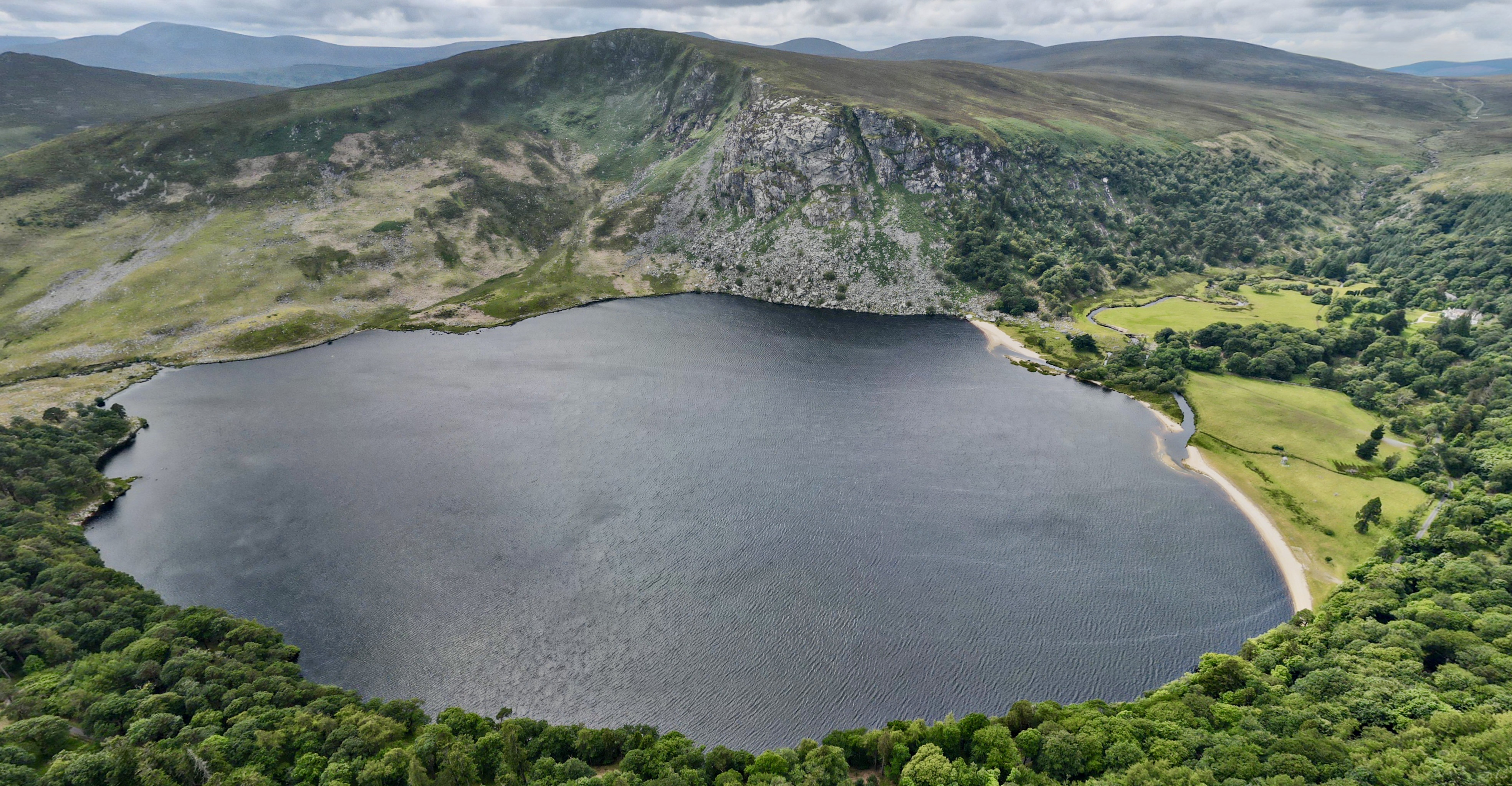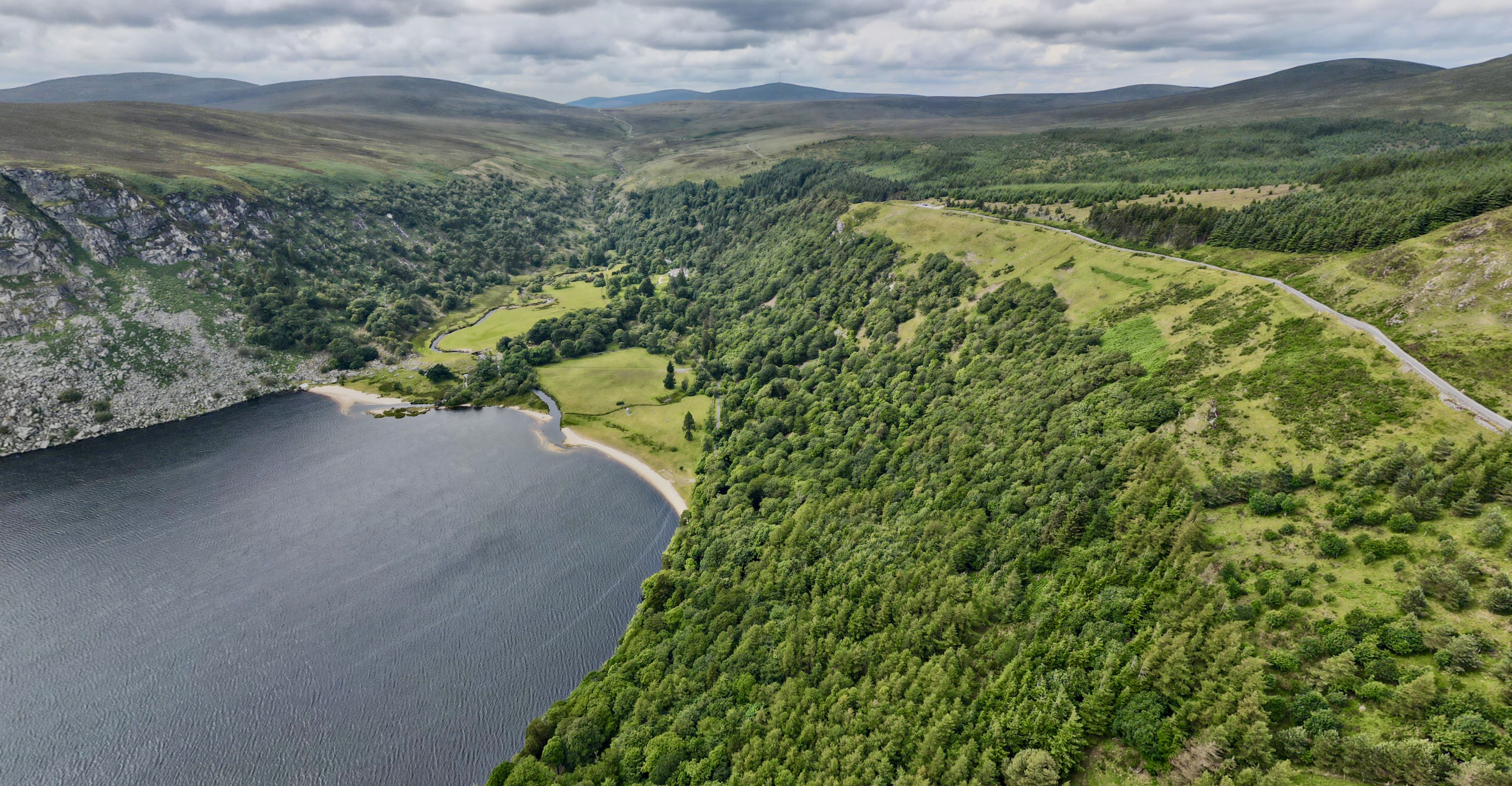
Hidden in the heart of the Wicklow Mountains lies one of Ireland?s most picturesque natural wonders ? Lough Tay, famously known as Guinness Lake. With its striking contrast of dark waters and bright sandy shoreline, this glacial lake resembles a perfect pint of Guinness, Ireland?s beloved stout. But beyond its iconic appearance, Lough Tay is a site steeped in natural beauty, cinematic history, and cultural heritage.

Why Is Lough Tay Known as Guinness Lake?
Lough Tay earned its nickname due to its unique resemblance to a pint of Guinness. This isn?t a natural coincidence ? the effect was intentionally enhanced by the Guinness family, who owned the surrounding Luggala Estate. They imported white sand to line the northern shore, creating a frothy "head" effect that, when viewed from above, mimics a pint of the dark Irish stout. The Guinness family acquired the Luggala Estate in the 1930s. Their private residence, Luggala Lodge, became a bohemian retreat for artists, writers, and musicians throughout the 20th century. Figures like Mick Jagger, Bono, and Michael Jackson reportedly stayed there, turning the estate into a symbol of Irish creative freedom.
Geological Origins
Lough Tay is a glacial lake, formed during the last Ice Age over 10,000 years ago. Its basin was carved by retreating glaciers, and today it lies nestled between the Djouce and Luggala mountains. The lake is approximately 1.5 kilometers long and sits at an altitude of about 240 meters (787 feet) above sea level. Its dark waters come from peat deposits in the surrounding uplands, which naturally tint the water with a deep brown hue ? adding to its Guinness-like appearance.
Location and How to Get There
Lough Tay is located in County Wicklow, between the picturesque villages of Roundwood and Enniskerry, and can be accessed via the R759 road, which intersects the Sally Gap, one of Ireland?s most scenic mountain drives.
- By Car: From Dublin, take the R115 south through the Wicklow Mountains National Park, then follow signs for the R759. Parking is available at a lay-by near the viewpoint.
- By Tour: Many guided day tours from Dublin include a stop at Lough Tay along with other sites like Glendalough or Powerscourt.
- By Public Transport: There is no direct bus route to the lake. Public transport can get you close, but a car or tour is strongly recommended.
Can You Visit the Lake Shore?
Lough Tay lies within private property and public access to the lake?s edge is restricted. Swimming or hiking down to the shore is not permitted. However, the best view is from the R759 scenic lookout, which offers a panoramic perspective from above. On clear days, you?ll see the shimmering black lake nestled between rolling green hills and granite cliffs.

Luggala Estate and the Guinness Legacy
The surrounding Luggala Estate spans over 5,000 acres and is one of Ireland?s most storied properties. Originally built in the 18th century, Luggala Lodge is an example of Gothic Revival architecture and was home to Garech Browne, a member of the Guinness family and a passionate patron of Irish music and culture. Garech founded Claddagh Records, a label dedicated to traditional Irish music, and his gatherings at Luggala attracted the likes of Seamus Heaney, Samuel Beckett, and The Chieftains. Though the estate changed hands in recent years (sold in 2019), its cultural legacy remains embedded in Irish artistic folklore.
Lough Tay on Screen: Film & TV Fame
One of the reasons Lough Tay has become globally recognized is due to its role in the hit TV series Vikings (History Channel). The lake served as the visual setting for the village of Kattegat, the home of Ragnar Lothbrok and his clan. Filming took place on a specially built set near the shore, taking full advantage of the lake?s dramatic backdrop.
The area has also featured in movies such as Excalibur (1981) and Leap Year (2010), and continues to be a favorite spot for filmmakers due to its untouched, cinematic landscape.
Nearby Attractions and Hiking Trails
Lough Tay is a great starting point for exploring Wicklow?s vast natural offerings. Consider adding these nearby highlights to your itinerary:
- Wicklow Way ? One of Ireland?s oldest long-distance walking trails, passing just west of Lough Tay.
- Djouce Mountain ? A moderate hike from the JB Malone Memorial Park offers breathtaking views over Lough Tay.
- Glenmacnass Waterfall ? A cascading waterfall set in an open valley, ideal for photo stops.
- Glendalough Monastic Site ? A 6th-century monastic settlement surrounded by lakes and hiking trails.
- Powerscourt Estate & Gardens ? One of Ireland?s grandest manor homes, with formal gardens, waterfalls, and cafes.
Tips for Visiting Lough Tay
- Go early or late to avoid crowds, especially on weekends.
- Clear days offer the best views ? check the forecast before heading out.
- Wear layers ? Wicklow weather can change quickly, even in summer.
- Pack water and snacks, as there are no facilities near the viewpoint.
- Bring binoculars or a zoom lens for wildlife spotting and better photos.

Conclusion
Lough Tay is more than just a pretty stop ? it?s a symbol of Ireland?s fusion of natural beauty, mythology, and cultural expression. From Viking legends to literary gatherings, from geological wonders to cinematic fame, Guinness Lake captures the imagination and spirit of anyone who visits. Whether you?re chasing iconic views, cinematic backdrops, or a moment of peaceful reflection, Lough Tay is a Wicklow must-see ? and a place you?ll remember long after you leave.
? Start Your 360° Journey Now
Experience Wicklow like never before. Step into ancient ruins, hidden trails, and breathtaking views ? all in immersive 360°.
Pick a destination below and explore:
Pick a destination below and explore:
? Glendalough 360° Tour
? Black Rock Castle
? Devil?s Glen Nature Walk
? Magheramore Beach
[Browse All Virtual Tours]
? Discover the Stories Behind the Places**
Our blog brings Wicklow?s magic to life. Explore history, legends, local secrets, and travel tips to plan your perfect adventure.
Read our featured articles:
? Devil?s Glen, Wicklow: Trail Guide, History, Curiosities and an Immersive Sensory Experience
? Glendalough: Where Time Whispers Between Lakes and Ruins
? Wicklow: The Garden of Ireland ? Discover the Charm of the Region
?? Download Your Free Guide: 3-Day Itinerary in Wicklow
Want to explore even more? Get our FREE 3-Day Itinerary for Wicklow, including hidden trails, castles, beaches and scenic towns ? with interactive maps and a printable checklist.